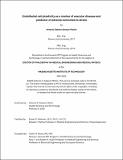Endothelial cell plasticity as a marker of vascular disease and predictor of adverse outcomes to stress
Author(s)
Salazar Martín, Antonio Gabino
DownloadThesis PDF (7.986Mb)
Advisor
Edelman, Elazer R.
Terms of use
Metadata
Show full item recordAbstract
Endothelial cells (ECs) dynamically sense and adapt to their local biomechanical and biochemical environments, a process crucial for maintaining vascular homeostasis. Loss of this plasticity is implicated in vascular diseases, where endothelial dysfunction and maladaptive responses exacerbate disease progression and limit therapeutic efficacy. We investigated the role of endothelial cell plasticity under pathophysiological conditions and its impact on therapeutic interventions – mechanical, pharmacologic and genetic. Specifically, Aim 1 characterizes the modulation of EC plasticity by shear stress, revealing that flow patterns drive distinct transcriptional signatures and subpopulation behaviors, as demonstrated through singlecell transcriptomics in human aortic endothelial cells. Aim 2 examines the interplay between EC dynamism and antiproliferative drugs, in particular rapamycin and paclitaxel – the agents released from drug-eluting stents, showing that biomechanical cues from flow dominate EC responses, potentially limiting drug efficacy in regions of disturbed flow. Aim 3, extends the investigation by moving beyond the overwhelming of cells with pharmacologic dosing into the domain of controlled genetic modification, which is in concert with the direction of modern therapeutics and also provides a further dimension to the perspective of endothelial biology. We sought to discern if genetically modified cells maintain their characteristic "endothelial" profile or if the interplay among genomic alterations, transcriptional and proteomic shifts, and environmental cues leads to a state that challenges the hypothesis that ECs remain plastic until they become committed to flow. The integration of single-cell transcriptomics and in vivo models provides novel insights into the heterogeneity of endothelial responses and underscores the importance of considering biomechanical and biological factors in developing targeted therapeutic strategies for vascular diseases.
Date issued
2025-05Department
Harvard-MIT Program in Health Sciences and TechnologyPublisher
Massachusetts Institute of Technology